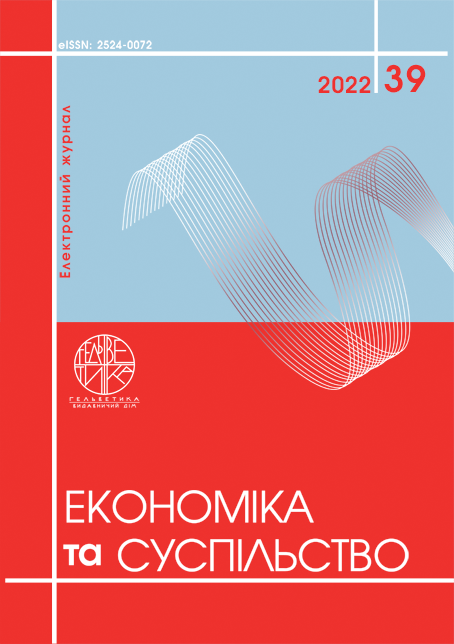TRENDS OF ENTREPRENEURSHIP DEVELOPMENT IN UKRAINE IN INDUSTRY 4.0
Abstract
Industry 4.0 definitely changes the external environment of business, creating many benefits, which is to obtain reliable information that allows you to make the right decision for business, the use of advanced technologies to increase productivity, reduce material and capital intensity. The purpose of the article is to identify trends in entrepreneurship in Ukraine in the context of Industry 4.0 in the context of the concept of sustainable development. The study involved the use of methods of analysis - to determine trends in entrepreneurship in Ukraine at the macro level and methods of regression analysis. Regression analysis was used to assess the impact of indicators of business development at the macro level on the profitability of Ukrainian enterprises in the conditions of Industry 4.0. According to the results of the study, mostly unfavorable trends in the development of entrepreneurship at the macro level were identified. This is the lack of an effective mechanism for regulating insolvency: significant duration, significant costs, focus on liquidation of the debtor; the presence of significant restrictions on the free movement of labor, goods, capital; low investment attractiveness of the country. Based on the financial statements of 276 Ukrainian companies (163 small and medium-sized businesses, 113 large enterprises) for the period 2016-2021 and the values of indicators of business development at the macro level, regression models were built. The results of the built regression models revealed a significant impact of the human capital development index on the profitability of all enterprises, regardless of their size. The profitability of small and medium-sized enterprises is also influenced by the dynamics of the index of ease of doing business and economic freedom. The profitability of large enterprises is significantly influenced by the rate of foreign direct investment. The obtained results indicate the priority directions of entrepreneurship development at the macro level and key areas of neutralization of threats to the development of entrepreneurship at the micro level in the conditions of Industry 4.0.
References
Döbler T.M. Swim, not just float. Driving innovation and new business models through Industry 4.0 / T.M. Döbler et al. 2020. URL: https://www2.deloitte.com/us/en/insights/focus/industry-4-0/industry-4-0-business-models.html
Нескородєва І.І. Особливості функціонування фондового ринку України. Вісник НБУ. 2013. № 2 (204). С. 36–42.
Neskorodeva I., Pustovgar S. An Approach to Predicting the Insolvency of Ukrainian Steel Enterprises Based on Financial Potential. Journal of Eastern European and Central Asian Research (JEECAR). 2015. №2 (2), 11. DOI: https://doi.org/10.15549/jeecar.v2i2.104
Kitsios F., Kamariotou M., Grigoroudis E. Digital Entrepreneurship Services Evolution: Analysis of Quadruple and Quintuple Helix Innovation Models for Open Data Ecosystems. Sustainability. 2021. № 13, 12183. DOI: https://doi.org/10.3390/su132112183
Megits N., Neskorodieva I., Schuster J. Impact assessment of the COVID-19 on trade between Eastern Europe and China. Journal of Eastern European and Central Asian Research (JEECAR). 2020. № 7 (3). Р. 385–399.
Predictive Model for Assessing the Impact of the COVID-19 Pandemic on the Economies of Some Eastern European Countries. Open Innov. Technol. Mark. Complex. 2020, № 6, 92. DOI: https://doi.org/10.3390/joitmc6030092
Valiyev A. The Digitalization Effectiveness as an Innovative Factor Development of the Agriculture in Azerbaijan. Journal of Eastern European and Central Asian Research (JEECAR). 2022. № 9 (2). Р. 194–205.
De la Vega I., Puente J.M., Sanchez R. M. The Collapse of Venezuela vs. The Sustainable Development of Selected South American Countries. Sustainability. 2019. № 11 (12), 3406. DOI: https://doi.org/10.3390/su11123406
Megits N. The «Five-Helix» Model as an effective way to develop business in Industry 4.0 of selected countries. Journal of Eastern European and Central Asian Research (JEECAR). 2022. № 9 (2). Р. 357–368.
Heritage Foundation. 2022. URL: https://www.heritage.org/index/explore?view=by-region-country-year&u=637512111452930563
World Bank. 2022. URL: https://data.worldbank.org/indicator
Siemens. Digitalization and alternative energy sources. 2021. URL: https://press.siemens.ru/search/58426.html
EViews. User’s Guide. 2021. URL: http://www.eviews.com/help/helpintro.html#page/content/preface.html#wwconnect_header
Döbler T.M., Sniderman B., Mahto M., Ahrens, C. (2020). Swim, not just float. Driving innovation and new business models through Industry 4.0. Available at: https://www2.deloitte.com/us/en/insights/focus/industry-4-0/industry-4-0-business-models.html
Neskorodyeva I.I. (2013) Osoblyvosti funktsionuvannya fondovoho rynku Ukrayiny [Features of the stock market of Ukraine]. Bulletin of the NBU. № 2 (204), рр. 36–42.
Neskorodeva I., Pustovgar S. (2015). An Approach to Predicting the Insolvency of Ukrainian Steel Enterprises Based on Financial Potential. Journal of Eastern European and Central Asian Research (JEECAR), 2(2), 11. DOI: https://doi.org/10.15549/jeecar.v2i2.104
Kitsios F., Kamariotou M., Grigoroudis E. (2021). Digital Entrepreneurship Services Evolution: Analysis of Quadruple and Quintuple Helix Innovation Models for Open Data Ecosystems. Sustainability, 13, 12183. DOI: https://doi.org/10.3390/su132112183
Megits N., Neskorodieva I., Schuster J. (2020). Impact assessment of the COVID-19 on trade between Eastern Europe and China. Journal of Eastern European and Central Asian Research (JEECAR), 7(3), 385–399.
Vasiljeva M., Neskorodieva I., Ponkratov V., Kuznetsov N., Ivlev V., Ivleva M., Maramygin M., Zekiy A. (2020). A Predictive Model for Assessing the Impact of the COVID-19 Pandemic on the Economies of Some Eastern European Countries. J. Open Innov. Technol. Mark. Complex., 6, 92. DOI: https://doi.org/10.3390/joitmc6030092
Valiyev A., Rustamov F. V. oglu, Huseynova R. A., Orujova M. S., Musayeva S. N. (2022). The Digitalization Effectiveness as an Innovative Factor Development of the Agriculture in Azerbaijan. Journal of Eastern European and Central Asian Research (JEECAR), 9(2), 194–205.
De la Vega I., Puente J.M., Sanchez R. M. (2019). The Collapse of Venezuela vs. The Sustainable Development of Selected South American Countries. Sustainability, 11(12), 3406. DOI: https://doi.org/10.3390/su11123406
Megits N., Aliyev S. T., Pustovhar S., Bielialov T., Prokopenko O. (2022). The «Five-Helix» Model as an effective way to develop business in Industry 4.0 of selected countries. Journal of Eastern European and Central Asian Research (JEECAR), 9(2), 357–368.
Heritage Foundation. (2022). Available at: https://www.heritage.org/index/explore?view=by-region-country-year&u=637512111452930563
World Bank. (2022). Available at: https://data.worldbank.org/indicator
Siemens. (2021). Digitalization and alternative energy sources. Available at: https://press.siemens.ru/search/58426.html
EViews. User’s Guide. 2021. Available at: http://www.eviews.com/help/helpintro.html#page/content/preface.html#wwconnect_header


